Luminous intensity and luminous flux converter
Introduction
Many years ago, when filament light bulbs where widely used and were almost
the standard light source for everyday use, choosing a suitable lamp was
quite easy: one "only" had to select the most suitable power for
the intended application.
Today it's much more complicated: there are standard filament light bulbs,
halogen light bulbs, compact fluorescent lamps, fluorescent tubes and LED
lamps of many different kinds.
All these lamps have different efficiencies and illumination patterns making
the choice much more difficult.
Just by looking at lamp power in Watts doesn't tell much about the effective
light output.
To overcome this problems luminous intensity Iv (expressed
in candelas) and luminous flux F (measured in lumens) are a
better choice, but unfortunately only a few people are used to these units
and their meaning is sometimes misinterpreted.
Lamp manufacturers often specify one of these figures on the package, but
rarely both, so comparing a lamp producing 1000 lm with another
producing 250 cd is not straightforward: will they illuminate with the
same brightness?
The goal of this calculator is to help converting from lumens to candelas for
selecting the appropriate light source.
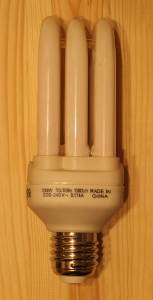
This compact fluorescent lamp uses 20 W of electric power and
produces a (nominal) luminous flux of 1'300 lm.
Supposing an omnidirectional radiation pattern (cone angle of 360°), with
the calculator provided below, you can estimate a luminous intensity of about
103 cd. You can also calculate the lamp efficacy of 65 lm/W.
(click to enlarge)
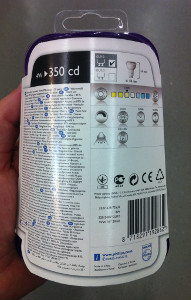
This LED lamp uses 4 W of electric power and produce a (nominal)
luminous intensity of 350 cd in a cone full angle of 36°.
With the calculator provided below, you can estimate a luminous flux of about
108 lm.
You can than calculate the lamp efficacy of 27 lm/W.
(click to enlarge)
Why photometric units?
In physics, radiometric units are used: for example, a given radiation
(light) source radiates an amount of power P (measured in Watts) and
we can easily compute the radiant intensity J (measured in W/ster) or
the irradiance E (measured in W/m2) if we want to know the
amount of power radiated in a give direction (solid angle) or on a given
surface, respectively.
But when we talk about visible light, we have to take into account the
sensitivity of the human eye, because the
sensation of brightness depends on the color (spectrum) of the light.
Therefore photometric units are preferred.
The photometric equivalent of the radiant power is the luminous flux
(or luminous power) F (measured in lumens).
Than, the luminous intensity Iv (expressed in candelas)
corresponds to the luminous flux in a given solid angle Ω
(1 cd = 1 lm/ster), while the illuminance
Ev (measured in lux) corresponds to the luminous flux on a
given area (1 lx = 1 lm/m2).
| Radiometric units |
Photometric units |
Radiant power
P
Watts
[W] |
Luminous flux
F
Lumens
[lm] |
Radiant intensity
J
Watts per steradian
[W/ster] |
Luminous intensity
Iv
Candelas
[cd = lm/ster] |
Irradiance
E
Watts per square metre
[W/m2] |
Illuminance
Ev
Lux
[lx = lm/m2] |
Luminous intensity vs luminous flux
In photometry, luminous flux is the measure of the total perceived
power of light while luminous intensity is a measure of the perceived
power emitted by a light source in a particular direction per unit solid
angle.
This means that the maximum luminous intensity depends on the total luminous
flux of a light source, but also on its radiation pattern (the way the light
source radiates in all directions).
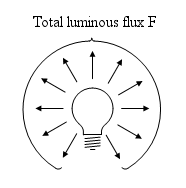
The total luminous flux is the sum of all the flux emitted in all
directions, no matter what radiation pattern the light source has.

The luminous intensity is the luminous flux in a given solid angle.
Here two examples of different luminous intensities in two arbitrary cones,
supposing the radiation pattern of this lamp is not uniform.
So, a same light source radiating the same luminous flux (the same lumens)
may produce different luminous intensities (different candelas) according to
its ability to concentrate light.
If you put a lens in front a lamp to concentrate the light in one direction,
the luminous intensity in that direction will increase, while the total
luminous flux stays the same.
The higher the ability to concentrate the light in one direction, the grater
the luminous intensity.
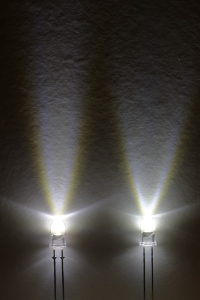
These 2 LEDs have the same chip producing the same luminous flux of
0.2 lm with a current of 30 mA.
The one on the left has a lens that concentrates the light in a narrow cone
of 15° while the one on the right has a different lens concentrating the
light in an cone of 30°.
As a result, the luminous intensity is 3.7 cd for the LED on the left
and 0.9 cd for the one on the right. (click to enlarge)
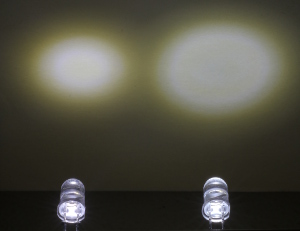
The same 2 LEDs projecting on a screen about 5 cm away.
Please remark that the LED on the left produces a smaller and brighter spot.
Unfortunately, in this HDR image, the difference in brightness is only barely
visible. (click to enlarge)
Exact conversion between luminous intensity and luminous flux
In order to precisely calculate the total luminous flux F we need to
take into account the radiation pattern I(θ) of the light
source.
Without the radiation pattern, it's not possible to do the conversion.
Precise numerical data of the radiation pattern is very rarely available, but
if one has the chance to have a datasheet with a nice radiation pattern plot,
a free program like Engauge Digitizer can be used to convert a plot into
numerical values.
Almost all light sources have a symmetric radiation pattern, therefore we
only use the data from 0° to 180° (0 to π) and we assume this will
stay the same if the device turns around about its optical axis.
Knowing I(θ) we can calculate the equivalent solid angle
Ω (in steradians):

To calculate this integral, you need a numerical computational program like
MATLAB, the free Scilab or maybe even a spreadsheet.
In any case, this is out of reach of a simple JavaScript calculator like the
one you find in these pages.
Please remark that I(θ) must be normalized in amplitude before
calculating the above integral, meaning that
max(I(θ)) = 1.
Ω represents the solid angle transmitting a constant and uniform
flux equal as the flux transmitted by I(θ) in 4π steradians
(the whole sphere surface).
This should actually be a double integral in θ and φ
covering the whole sphere around the light source, but because of the
symmetric radiation pattern of most light sources, the integral in
φ can be simplified to just a factor 2π.
It's now easy to calculate the luminous flux F in lumens:

Where Iv is the maximum luminous intensity measured in
candela (cd).
Simple luminous intensity/flux converter
Very often the radiation pattern of a lamp is not known, but if we know the
beamwidth (beam divergence) 2θ, which is angle of the cone of
light emitted, we can do an approximate calculation.
This is an approximation because it assumes that all the power is uniformly
distributed inside this cone and that no power is emitted outside.
Beamwidth is usually given as the cone full angle 2θ, which is
the double of the cone angle θ between the axis and the cone.
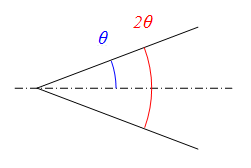
In this drawing you can see in blue
the cone angle θ and in
red the cone full
angle 2θ.
With this approximation, we assume all the flux is uniformly distributed in
the specified cone and that there is no radiation outside.
This, of course, is not very accurate.
Keep in mind the real figures could considerably off but is the best you can
get with just the cone angle.
But usually the order of magnitude is right.
The advantage is that the conversion is now easy and can be done with a
pocket calculator or this JavaScript converter.
Knowing the beamwidth 2θ, we can easily calculate the
corresponding solid angle Ω in steradians with:

Than we can use the same equation as before to convert between the luminous
flux F and the maximum luminous intensity Iv:

The following calculator will do the math for you:
Mobile version available here, if you
need to do conversions while shopping for lamps...
Enter all the known data in the calculator below and leave the fields to
calculate blank, than click the "calculate" button to compute and
fill in the blanks.
Not all combinations are possible; if not enough data is available; a pop-up
box will warn you.
Make sure the unknown fields are completely empty: a space character will not
work.
What about radiant power?
Now that we know the luminous flux F, can we compute the radiant power
P, or vice versa?
Well, in theory yes, but it's not that simple because you need to know the
spectrum P(λ) of the emitted light to calculate the
corresponding conversion factor.
Sometimes manufacturers provide you a nice spectrum plot, otherwise you need
to measure it with an optical spectrometer (and if you own one, you probably
don't need the explanations in this page).
Without precise spectral data, it's not possible to convert from F to
P.
Assuming that you know P(λ) (measured, digitized from a plot of
provided by the manufacturer), the first thing you have to do is normalize it
in surface (the surface under the curve should be equal to one):

Again, this is out of reach of this JavaScript calculator and you would need
a powerful numerical computational program.
Once you are sure that P(λ) is normalized, you can calculate
the radiant to luminous flux conversion factor ηv:

Where V(λ) is the standard
luminosity function (photopic vision) and you should integrate for the
whole visible spectrum (let's say from λmin =
380 nm to λmax = 770 nm) or at least
the portion where P(λ) is nonzero.
Knowing ηv, it's now possible to convert between
radiant and luminous flux with the following relation:

Please remark that ηv is expressed in lm/W but is not
the efficacy of a lamp, it's just a measure of the visibility of the light
for the human eye.
Lamp efficacy, expressed in lm/W as well, also take into account lamp losses.
In other words, if you have precise spectral data and a suitable numerical
computational software you can do it, but still you need a lot of motivation
to overcome these two obstacles.
And you don't need to just for buying a light bulb…
Lamp luminous efficacy
The luminous efficacy of a lamp is the ratio between the produced luminous
flux and the used electrical power and is expressed in lumens per watt
(lm/W), the higher the better.
This depends mainly on lamp technology: old filament lamps have very low
efficacies, halogen lamps do a little better, fluorescent lamps and LED have
the best efficacies (for white light) today (2013).
Please remark that the used electric power is different from (and always
higher than) the radiant power discusses before.
In order to compute lamp efficacy, it's not necessary to calculate or know
the radiant power.
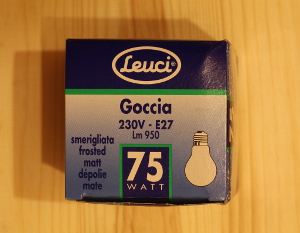
This old fashion filament lamp uses 75 W of electric power and
produces a (nominal) luminous flux of 950 lm.
Supposing an omnidirectional radiation pattern (cone angle of 360°), with
the calculator provided above, you can estimate a luminous intensity of about
76 cd.
You can also calculate the lamp efficacy of 13 lm/W.
(click to enlarge)
Incandescent lamps, no matter if halogen or not, have better efficacy for
large powers, because the hotter
filament generate more visible light.
So, a single 75 W light bulb with its 13 lm/W is more efficient
than two 40 W bulbs with only 10 lm/W.
Colored filament light bulbs have very low efficacy because the majority of
the light is filtered out by the colored glass leaving just one portion of
the spectrum.
On the other hand, colored discharge lamps or LEDs have very high efficacy
because only the required color is emitted and no compromise is made to
obtain white light.
For this reason, in many countries, street lights are yellow: sodium lamps
have very good luminous efficacy but produce their ugly yellow light.
For white lamps, in general, the most efficient discharge or LED lamps
produce cold (bluish) light and do not render colors very well; this may
change in the future.
Finally, clear lamps have better efficacy than diffuse ones, but are
sometimes disturbing to watch.
Adding a diffuser to a clear lamp will of course drop its efficacy.
The following table summarizes usual luminous efficacies of common white
house lamps:
| Lamp type: |
Luminous efficacy: |
| Standard filament lamps |
8...15 lm/W |
| Halogen filament lamps |
15...20 lm/W |
| Compact fluorescent lamps |
30...60 lm/W |
| Fluorescent tubes |
60...110 lm/W |
| Modern LED lamps |
60...100 lm/W |
For almost all types of lamps except LEDs, luminous efficacies are more or
less stable since many years and there are no big surprises.
For LEDs, efficacy is continuously improving: ten years ago the efficacy of
LED lamps was comparable to halogen lamps, the first efficient LEDs had very
low power levels and were almost useless.
Today (in 2013) it's possible to buy good LED lamps with efficacies in excess
of 100 lm/W in the local general store and this figure is still growing.
Conclusion
Two basic photometric concepts, luminous flux and luminous intensity have
been briefly described and a simple approximate calculator to convert between
the two is available in this page.
Than some aspects of the conversion between radiant and luminous flux have
been explained, but unfortunately, there is no simple way to convert between
them.
Finally lamp luminous efficacy has been discussed.
The goal is to help comparing lamps or light sources in general when complete
technical data is not available.
Bibliography and further reading
| [1] |
Warren J. Smith.
Modern Optical Engineering - The Design of Optical Systems.
3rd Edition, McGraw-Hill, 2000,
chapter 8.
|
| [2] |
A. Daeschler, G. Camponovo.
Elettrotecnica.
Edizioni Casagrande, Bellinzona, 1974,
capitolo 11.
|













